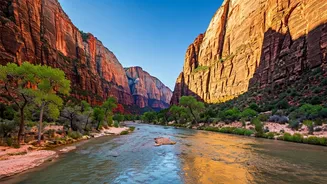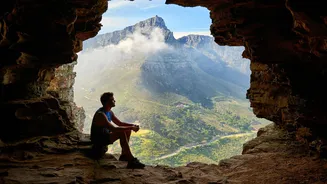Best Time to Visit
Deciding when to visit Zion National Park greatly impacts your experience. The peak season, from spring to fall, offers the warmest weather and full access
to all trails and activities. However, it also brings the largest crowds and higher accommodation costs. Summer months see temperatures soaring, which can make hiking strenuous, especially during midday. Winter, though cold, presents a quieter experience with fewer visitors. Some trails may be closed due to snow and ice, but the stark beauty of the park under a blanket of snow is unparalleled. Spring and fall provide a balanced experience, with pleasant temperatures and fewer crowds compared to summer. To avoid the biggest crowds, aim for weekdays or early mornings. Consider visiting during the shoulder seasons (April-May and September-October) for a good balance of weather and visitor numbers. It's crucial to check the park's website for any trail closures or seasonal changes before your trip. Always be prepared for varying weather conditions and pack accordingly, including layers, sunscreen, and plenty of water, especially if you plan to hike.
Camping in Zion
Camping in Zion National Park is a fantastic way to immerse yourself in nature. There are three campgrounds within the park: Watchman, South, and Lava Point. Watchman and South Campgrounds are located near the visitor center and are incredibly popular, requiring reservations well in advance, often several months ahead. They are open year-round, offering easy access to the park's main attractions and shuttle system. Lava Point Campground, located further inside the park, is more secluded and primitive, offering a quieter experience but with limited amenities and is typically open from spring to fall. Reservations are essential for Watchman and South Campgrounds through Recreation.gov. For those without reservations, camping outside the park in the nearby town of Springdale is an alternative, with numerous private campgrounds. When camping, be mindful of the park's regulations regarding campfires and food storage to protect both the environment and wildlife. Pack essentials like a tent, sleeping bag, cooking equipment, and a first-aid kit. Consider the time of year when packing, as temperatures can vary drastically between day and night. Remember to leave no trace by packing out all trash, staying on designated trails, and respecting the natural surroundings.
Beat the Crowds
Zion National Park is a popular destination, and with popularity comes crowds. To enhance your visit, strategically plan your trip to minimize the impact of crowds. The park's shuttle system is essential for navigating the main canyon, particularly during peak season. Park your car at the visitor center and use the shuttle to access trailheads, reducing congestion and parking difficulties. Arrive early at popular trails like Angels Landing and The Narrows to beat the midday rush. Consider visiting during the shoulder seasons (spring and fall) to enjoy milder temperatures and fewer visitors. Exploring less-visited trails, like the Pa'rus Trail or Canyon Overlook Trail, offers a quieter experience and stunning views. Be flexible with your plans, and willing to adapt to changing conditions. Check the park's website and social media for real-time updates on trail closures or shuttle delays. If you plan to hike Angels Landing, be aware that you will need a permit. Evenings are a great time to explore the park, as many day visitors depart, leaving the trails and viewpoints quieter. Enjoy the sunset views and stargazing. Remember to be patient and respectful of others, allowing everyone to enjoy the park's beauty.
Essential Tips
For a smooth and enjoyable experience, keep some expert tips in mind. Plan your trip in advance and make reservations for lodging and permits. Check the park's website for current conditions, including trail closures, weather forecasts, and shuttle schedules. Bring plenty of water, especially during warmer months, and drink it frequently to stay hydrated. Wear sturdy, comfortable footwear suitable for hiking on varied terrain. Pack appropriate clothing, including layers, to adapt to changing weather conditions. Protect yourself from the sun with sunscreen, hats, and sunglasses. Carry a first-aid kit for minor injuries. Let someone know your hiking plans and expected return time. Stay on marked trails to protect the fragile ecosystem and your safety. Respect wildlife by maintaining a safe distance and not feeding them. Be aware of your surroundings, and be prepared for potential hazards, such as flash floods. Before you enter the park, familiarize yourself with the park's regulations to ensure a safe and memorable visit. Be prepared for changing weather conditions and pack accordingly.












